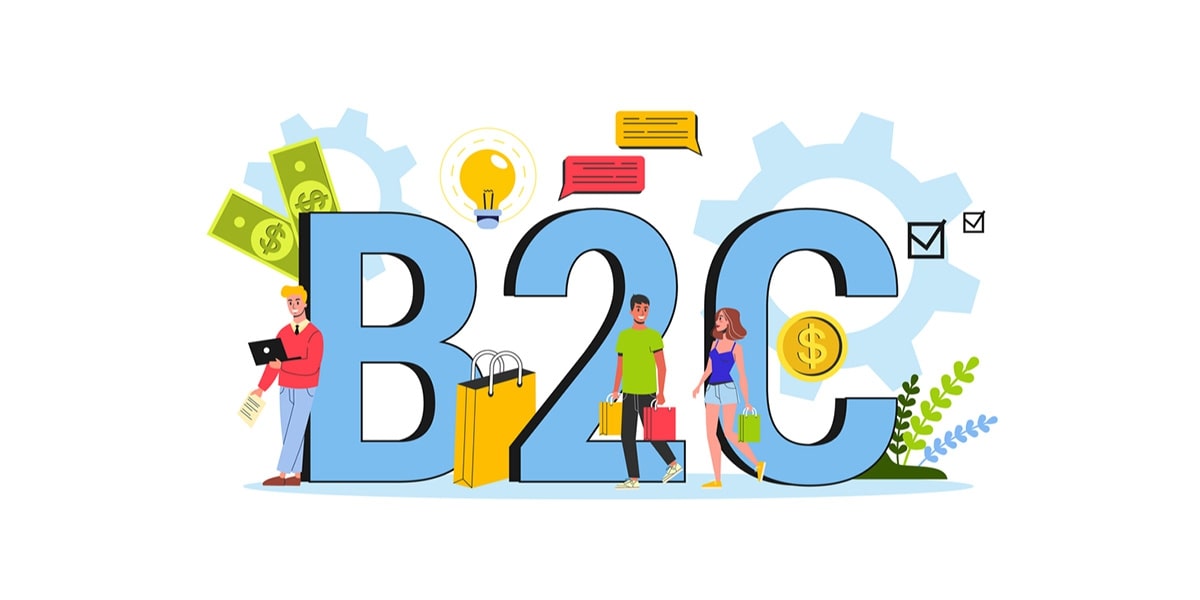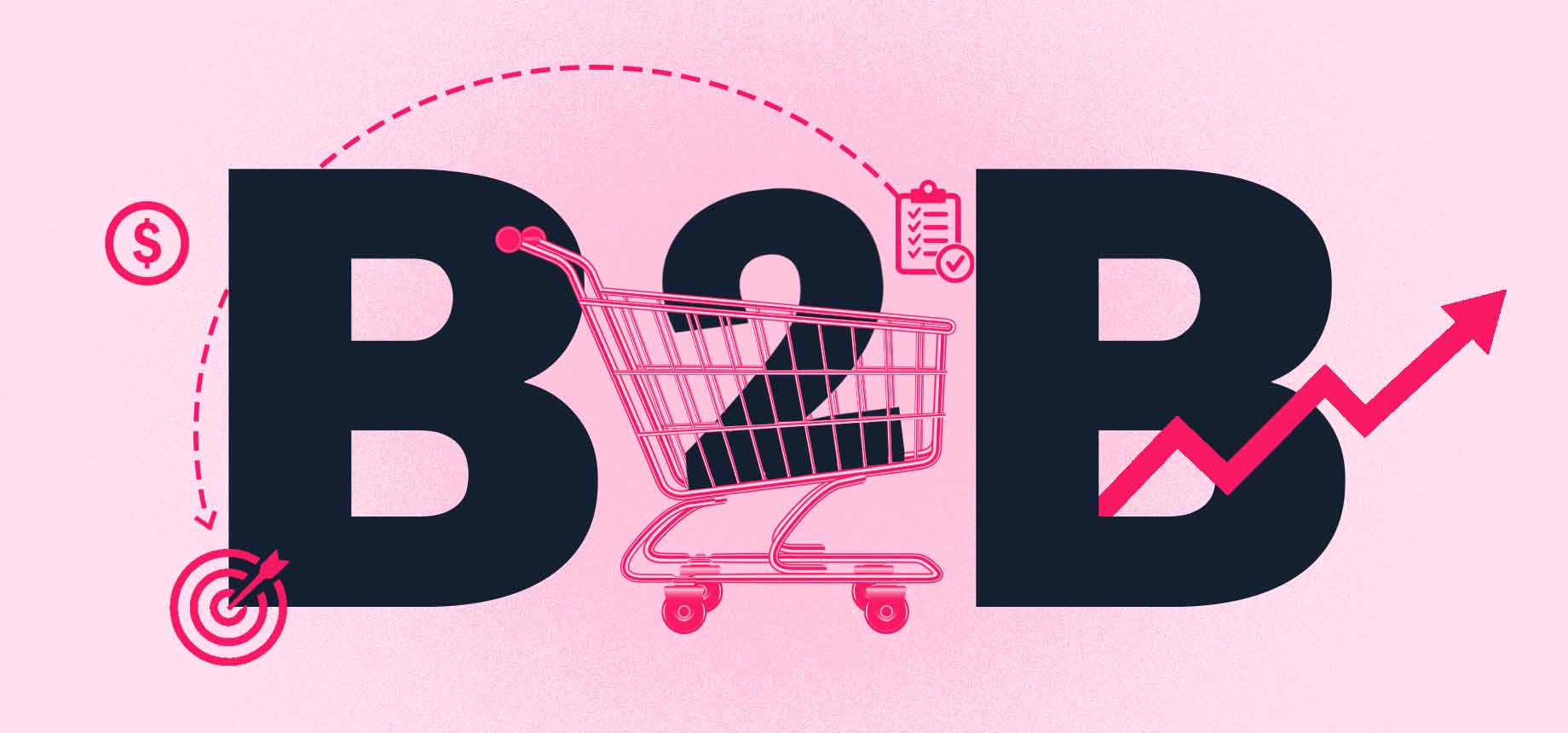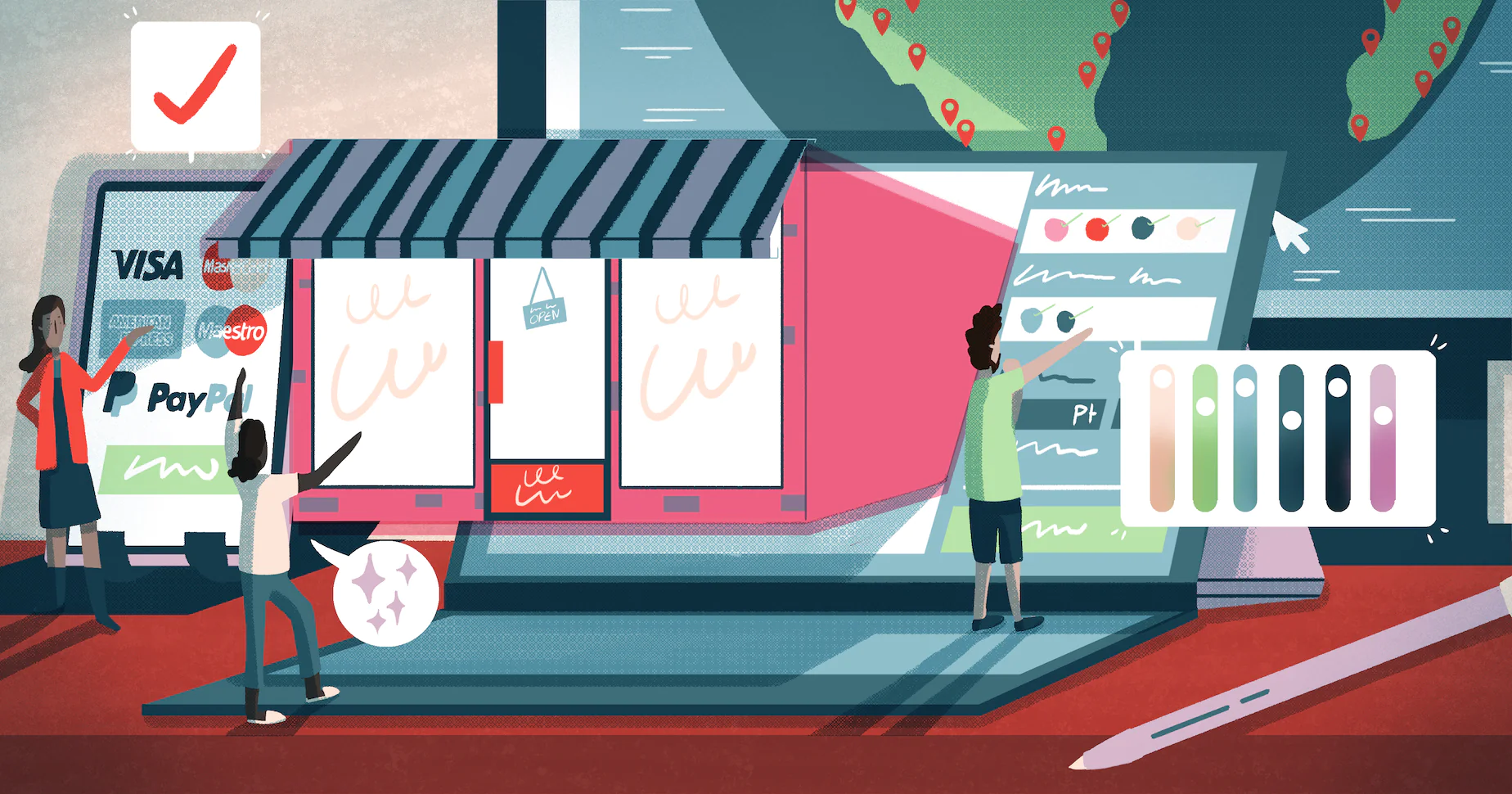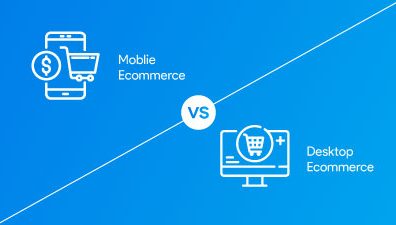In 2021, eCommerce business deals are expected to make up 14% of the all-out buys in the U.S. Deals from online stores are required to increment 385% this decade. A blasting eCommerce business takes instinct, information on your market, a strong strategy, and careful investigation into items and action plans. To take the first step in this eCommerce marathon, newbies have to understand deeply about types of eCommerce stores that fit them. In this blog, we will give you the different types of eCommerce websites that you can apply to establish your business.
Table of Contents
6 Types of eCommerce Businesses Models
The eCommerce website types of the business model are subject to who is purchasing and who is selling. Clients are not really singular purchasers – they can be different organizations or even government organizations. Moreover, a vendor is not a business, as purchasers offer things to one another all the time through various methods.
It is likewise feasible for specific organizations to utilize more than one of these models at the same time, for instance, offering to shoppers and different organizations simultaneously. Obviously, to do this effectively, certain contemplations should be made to manage the two sorts of clients, which to a great extent relies upon the eCommerce platform.
In case you are beginning an eCommerce business, chances are you will fall into in any event one of these four general classifications. Each has its advantages and challenges, and numerous organizations work in a few of these classifications simultaneously. Understanding what basin your huge thought fits in will help you figure imaginatively about what your chances and dangers may be. We will give you 6 types of eCommerce businesses models in the market now.
B2C – Business to Consumer
The B2C area is most of an opinion about when they envision an online business. This is the most profound market, and large numbers of the names you will see here are known amounts disconnected, as well. B2C internet business deals are the customary retail model, where a business offers to people; however, the company is led online rather than in an actual store.
B2C organizations offer their end-client. The B2C model is the most well-known plan of action, so numerous particular methodologies are under this umbrella. Anything you purchase in an online store as a customer – think closet, family unit supplies, amusement – is done as a feature of a B2C exchange.
The dynamic interaction for a B2C buy is a lot more limited than a business-to-business (B2B) buy, particularly for lower-esteem things. Consider everything: it is a lot simpler for you to settle on another pair of sneakers than for your organization to vet and buy another email specialist co-op or food caterer.
As a result of this more limited deals cycle, B2C organizations ordinarily spend less promoting dollars to make a deal. In addition, they have below request esteem and fewer repeating orders than their B2B partners.
What’s more, B2C does not just incorporate items, yet benefits too. As we are the customers, this is the model utilized by the majority of our number-one brands. From design to furniture, rec center participation to wine memberships (more on those later), a large portion of the stuff we purchase for ‘needs’ and ‘needs’ comes from a B2C brand.
B2C trend-setters have utilized innovations like portable applications, local publicizing, and remarketing to showcase straightforwardly to their clients and make their lives simpler all the while. For instance, using an application like Lawn Guru permits shoppers to handily interface with neighborhood grass-cutting administrations, nursery and porch-trained professionals, or snow evacuation specialists.
B2B – Business to Business
As its name would suggest, a B2B merchant gives items or administrations to different organizations. As a rule, B2B dealers supply items that end shoppers would not utilize, similar to crude materials utilized in assembling. Other B2B eCommerce models incorporate discount providers that offer items to retailers and providers of business supplies like office materials or marked worker clothing.
The B2B sales model is additionally common, yet not as regular as possible B2C, as one B2B business can supply quite a few clients confronting retailers, restricted exclusively by the stock it can create and the connections it can shape. B2B business gives the highest income and appears to a market with a steady need to resupply the offered items. The essential hindrances of the B2B model are that the market is a lot more modest, and the bigger scope implies more mind-boggling activities.
C2C – Consumer to Consumer
A C2C business – additionally called an online commercial center – associates buyers to trade products and enterprises and normally brings in their cash by charging exchange or posting expenses. This is the kind of eCommerce that includes people offering items to one another straightforwardly. For an offline model, you could think about a carport deal. On the web, huge commercial centers like eBay smooth out the C2C exchange measure for many vendors. Online organizations like Craigslist and eBay spearheaded this model at the beginning of the Internet.
C2C businesses profit by self-moved development by propelled purchasers and merchants yet face a vital test in quality control and innovation upkeep. C2C can be a gateway to an eCommerce business. Not exclusively would consumers be able to auction undesirable things, but they can likewise take in an incredible arrangement from eBay and different commercial centers. It includes how to structure an item posting, how to guide it toward the correct market, how to pack and transport an item whenever it has been sold, and that’s just the beginning.
A C2C seller can make some additional money and decide whether eCommerce is ideal for them. Large numbers of the present developing eCommerce organizations owe their beginnings to an originator who found they essentially had a talent for selling on the Internet.
C2B – Consumer to Business
This is a plan of action in which an individual shopper gives items or administrations to an association. Independent specialists, essayists, architects, and programming engineers are genuine models and attorneys, and bookkeepers who serve business needs. Bloggers who sell publicizing space on their sites are additionally captivating in a C2B exchange.
Good instances of C2B organizations would be a business expert, an independent visual planner, or an online media influencer with a huge crowd.
C2B has a fairly questionable nature because of the trouble numerous consultants have in discovering enough work. In this web-based business model, a web page may permit clients to post the work they need to be finished and have organizations offered the chance. Associate-promoting administrations would likewise be viewed as C2B.
C2B makers, who give an item to organizations, may battle to offer the number of items their business clients would require. This is the reason most C2B trade is administration-based.
Mixed Business Model
The technological advancements of eCommerce have smoothed out a wide range of business deals and procedures for all plans of action. This eCommerce website type of business model has additionally made it simpler for organizations to follow more than each model in turn, for example, by consolidating B2C and B2B deals on a solitary site.
It is conceivable today for an online store to introduce an end-purchaser shopping experience for general clients yet still offer mass wholesaling or other B2B-explicit administrations in an alternate piece of the site without mistaking things for one or the other arrangement of clients. B2B clients can be given distinctive estimating, various choices, and even unexpected items in comparison to B2C clients. Obviously, abilities like these rely upon the usefulness of the eCommerce programming utilized by the vendor.
B2G or C2G – Government and Public Administration eCommerce
The eCommerce retail structures described above are the most common, although they are not the only ones. Other kinds include the government or public administration engaging in interactions with companies or customers. This type of eCommerce business model seems unpopular, but we can deny its existence.
B2G (or B2A): refers to enterprises whose primary clientele are governments or other types of government administration. Businesses will gain sales from the government. Synergetics is one such company that supplies contractors and services to federal agencies.
C2G (or C2A): It occurs when people pay the government for taxes or university fees. Customers will receive services while the government has money.
3 Types of eCommerce Websites
We have covered plans of action and income models — presently, we should take a gander at the various different types of eCommerce websites that populate the consistent shopping of the web. Individual online stores of all sizes offer a lot of brands and decisions for clients.
Vendor Specific – Single Brand Seller: The Most Common Types of eCommerce Sites
A single brand website is one of the common types of eCommerce sites where a site merely sells the items or administrations of one business or individual. It is likewise the most widely recognized type of eCommerce store and presumably the kind of site you will begin.
These types of eCommerce websites follow their plans of action and sell their own items. Most online stores are of this kind. A vendor-specific eCommerce website has a solitary organization, which utilizes it as an online retail facade. Most organizations today, on the off chance that they sell items by any means, keep a vendor-specific eCommerce website to allow their clients to shop distantly.
Selected Seller – Single Brand Seller
This is one of the types of eCommerce websites that may incorporate items from a vendor who really possesses the actual website, yet will likewise incorporate items from different vendors that have been allowed to sell on the stage.
Amazon is one of the most incredible instances of successful types of eCommerce websites in the selected-seller retail field—Amazon itself sells items, yet additionally permits qualifying outsider merchants to partake. In fact, Amazon essentially advanced from a single-seller website to a selected seller website.
Online retailers unite items from isolated merchants under one online rooftop. The online retailer has command over which merchants it unites thusly. Frequently, the online retailer will likewise take responsibility for item photographs and portrayals to keep everything looking pleasant and arranged.
Amazon is presumably the most well-known online retailer. As opposed to a curated determination of dealers, Amazon selects amount and comfort – and it is absolutely working for them.
Multiple Sellers – Marketplace
The marketplace is one of the popular types of eCommerce websites with famous platforms like Amazon, eBay, and Etsy. Everybody can be a vendor in an online commercial center, from people to enormous organizations. Vendors do not have to experience any choice standards; anybody can make a record and begin utilizing the commercial center immediately. This implies tremendous openness to likely clients. Indeed, even organizations that have their own websites now, or sell on different sites, can profit by setting their items available to be purchased on a marketplace where clients are probably going to discover them.
However, it’s crucial to recognize that while the marketplace model offers numerous benefits, it also presents challenges. There’s intense competition among sellers, necessitating strong differentiation and unique selling propositions. Furthermore, since the marketplace operator controls the platform, sellers often have limited control over their storefronts, customer data, and other crucial business aspects. Organizations with huge budgets or financial resources can implement their own eCommerce marketplace to manage and control completely all the critical aspects of the businesses.
5 Revenue Models of eCommerce
Since eCommerce is tied in with giving an item or administration and bringing in cash, it is essential to comprehend distinctive revenue models. The most significant thing to consider is the manner by which you need to deal with stock administration and sourcing items. A few groups like making their own items, and others disdain the possibility of their garage loaded with boxes.
As you are setting up and choosing for yourself one of the new types of eCommerce website, you can pick at least one of these revenue streams:
Dropshipping
Dropshipping is the most basic type of eCommerce, allowing you to set up a shop and accept payments from consumers using credit cards or PayPal. The remainder is up to your vendor. This relieves you of inventory management, storing products, and dealing with packing, but there is a significant catch.
It is your responsibility if your sellers are sluggish, the quality of the good is lower than expected, or the order has difficulties.
Affiliate Marketing
Affiliate sales are the point at which you sell another person’s item on your site in return for a commission. Every time you succeed, you are paid a commission, which comes from the firm’s marketing budget that is sponsoring the affiliate program.
This is the best model for your partners because they just pay for you when you have sales. Thus, they can reduce the risk when spending too much money on marketing but not gaining more sales. However, you will live with an unstable money flow and depend deeply on your partners. They will replace you with others who can help them have more transactions.
Subscription
A subscription is a point at which you give to keep sending an item or offer assistance as a trade-off for a regularly scheduled installment. Customers charge their services or products they buy monthly or annually. This model allows you to use your client relationships to generate a consistent stream of money.
One of the famous examples is Netflix. Customers will pay money periodically as the package they subscribe to have accounts. With accounts, customers can access Netflix’s film store and watch films they want.
Private Labeling
Retailers get products from a third party and sell them under their brand name. Everything regarding the product or goods is under the retailer’s control. This covers the product’s specifications, packaging, and everything else.
If you have an issue with product quality, you can swiftly change providers. The initial expenses are low; so, this is an excellent method to test new products without too many risks.
White Labeling
You select a product already being sold effectively by another business but has white-label alternatives, create your box and label, and sell the product. Many retailers apply this method in the beauty and wellness industry.
One issue with white labeling is a lack of demand because the majority of these businesses have a minimum manufacturing amount. So, you have to consider the difference between the demand of customers and the supply of products.
Final Thought
Regardless of your thoughts for your business, there is a proper plan of action, income model, and eCommerce platform out there to cover it. The eCommerce website types you use are a pivotal choice that will influence your ability to follow your marketable strategy, so pick cautiously. We hope that with this information about types of eCommerce sites, you will know exactly what you want to boost your business. Thanks for reading!
At Magenest, we are your eCommerce partner with over six years of experience, offering a comprehensive suite of Shopify services, including expert Shopify website development services, seamless re-platforming from various platforms, custom theme design, and efficient app development to tailor your online store to perfection.
















